|
|
|
Sort Order |
|
|
|
Items / Page
|
|
|
|
|
|
|
| Srl | Item |
| 1 |
ID:
161540
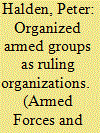

|
|
|
|
|
| Summary/Abstract |
Previous studies of the cohesion of organized armed groups (OAGs) have made great progress, but they have mostly focused on units fighting for modern Western states. I argue that the study of OAGs that contain their own legitimacy requires a broadened theoretical framework. Such groups may be conceptualized as “ruling organizations” in Max Weber’s terminology. Examples of such groups range from early medieval warbands to modern militias and guerrillas. Members of ruling organizations obey commands for a combination of three reasons: rational, traditional, and charismatic—these in turn form the basis of the legitimacy of the organization. Pinpointing the foundations of obedience in a group provides us with another way of emphasizing weak points that we want to either target or reinforce. This study contributes theoretically to the study of cohesion by linking it to theories of legitimacy in political orders.
|
|
|
|
|
|
|
|
|
|
|
|
|
|
|
|
| 2 |
ID:
163577
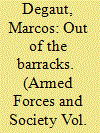

|
|
|
|
|
| Summary/Abstract |
Why some democratic revolutions succeed while others fail? The scholarly community has sought to address this issue from various perspectives, from rational choice approaches to collective action theories. Too little attention, however, has been paid to analyzing the role of the military. By discussing the different types of interactions played by the military in five cases of successful democratic revolutions—the 1910 Portuguese Republican Revolution, the 1958 Venezuelan Revolution, the 1960 April Revolution in South Korea, the 1989 Velvet Revolution in Czechoslovakia, and the 2000 Bulldozer Revolution in Yugoslavia—and three cases of failed revolutions, the 1905 bourgeois-liberal revolution in Russia, the 1989 Tiananmen Square Protests in China, and the 2016 Turkey’s coup attempt, this study finds out that the key factor in determining their outcome is the army’s response and that the military backing is a necessary condition for a democratic revolution to succeed.
|
|
|
|
|
|
|
|
|
|
|
|
|
|
|
|
| 3 |
ID:
193066
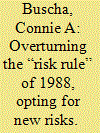

|
|
|
|
|
| Summary/Abstract |
The evolution of the status of American women as warriors between Operation Desert Shield/Desert Storm in 1990-1991 and the War in Afghanistan, beginning in 2001 [and simultaneously the Iraq War in 2003] is explored. This era of American civil-military history included rescinding the ‘Risk Rule’ of 1988, the formal ban on women serving in ground combat units. This generation of women’s legitimate military service as warriors began. The Afghanistan War period also exposed, however, the physical and emotional risks military women often face from their own colleagues on a global scale in the form of sexual violence. As a society, we purposefully must eliminate such risks inherent in the contemporary All-Volunteer Force (AVF) and clean up the resulting messes before we even consider taking the risk of conscription and mass mobilization of American women in our next war.
|
|
|
|
|
|
|
|
|
|
|
|
|
|
|
|
| 4 |
ID:
161542
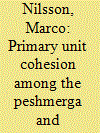

|
|
|
|
|
| Summary/Abstract |
This study analyzes the creation of primary unit cohesion among the Kurdish Peshmerga soldiers fighting the Islamic State in northern Iraq and among Hezbollah fighters active in Syria. For this comparative study, Kurdish soldiers were interviewed on three fronts outside Mosul, Erbil, and Kirkuk in February 2015 and May 2016, and Hezbollah fighters were interviewed in Lebanon in March 2016. In contrast to many studies’ depictions of unit cohesion as relating to shared experiences of training and battle, this study argues that the Kurdish soldiers also import into their units various ideas relating to Kurdish identity. These include ideas about nationalism and religion produced through discourses within the Kurdish military and society. However, Hezbollah seeks to minimize political damage in the multisectarian political context in Lebanon while conducting domestically contested military operations abroad. This has led to a downplaying of the sectarian aspects of the conflict, which could be imported from the Shia community to increase unit cohesion, and to an ideological framing of the conflict. The general ideas circulating in society and the political context therefore matter for the strategies that can be used to increase primary unit cohesion and soldiers’ fighting power.
|
|
|
|
|
|
|
|
|
|
|
|
|
|
|
|
| 5 |
ID:
174842
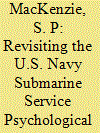

|
|
|
|
|
| Summary/Abstract |
Conclusions concerning how many World War II U.S. Navy submariners should be classified as psychiatric casualties have long been based on a pioneering study by two navy physicians, Commander Ivan Duff, MD, and Captain Charles Shilling, MD, that was first made public in the Journal of the American Psychiatric Association shortly after the war. This article seeks to show that, despite the longevity of the resulting published figures, there were serious problems in their approach and conclusions. The data set of the study was far from comprehensive, which, in turn, led to erroneous calculations generating a minuscule number—approximately two cases per 1,000 submariners—that in turn necessitated explanatory overreach. Reasons for the approach taken in the original work, and subsequent longevity of acceptance and celebration of the results produced, are then examined through the lens of confirmation bias.
|
|
|
|
|
|
|
|
|
|
|
|
|
|
|
|
| 6 |
ID:
161541
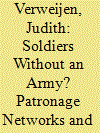

|
|
|
|
|
| Summary/Abstract |
This article analyzes the effects of patronage networks on cohesion in the Armed Forces of the Democratic Republic of the Congo. It shows that while patronage networks provide support to individual military personnel, they undermine both peer and commander–subordinate bonding. They promote unequal service conditions and statuses and link these to extra-unit and extra-military forms of social identification, which are further reinforced by soldiers’ living and generating revenue among civilians. Furthermore, they impair meritocracy and frustrate the extent to which commanders live up to their subordinates’ expectations. As they fuel internal conflicts, often around revenue generation, and foster bad service conditions and distrust toward the political and military leadership, patronage networks also undermine institutional cohesion. The article concludes that cohesion formation in the FARDC follows different patterns than in well-institutionalized and well-resourced militaries. Given that cohesion impacts combat performance and norm enforcement, these findings are relevant for defense reform efforts and military cooperation.
|
|
|
|
|
|
|
|
|
|
|
|
|
|
|
|
| 7 |
ID:
161539
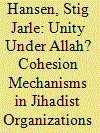

|
|
|
|
|
| Summary/Abstract |
This article explores mechanisms fostering cohesion in jihadist organizations in relation to territorial presence. This article takes four types of territorial presence as its point of departure: (1) a clandestine network-based presence; (2) an accepted presence where the organization is tolerated by a state; (3) a semiterritorial presence, where the organization is allowed some control between phases of enemy offensives and withdrawals; and (4) a relatively permanent territorial presence, where the organization fully controls the territory in which it has bases. The article argues that each of these types of territorial presence opens up for different ways for organizations to create cohesion. Cohesion mechanisms thus vary according to type of territorial presence.
|
|
|
|
|
|
|
|
|
|
|
|
|
|
|
|
|
|
|
|
|